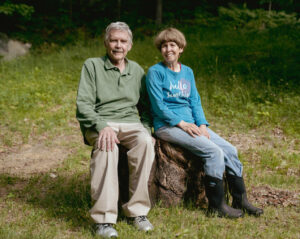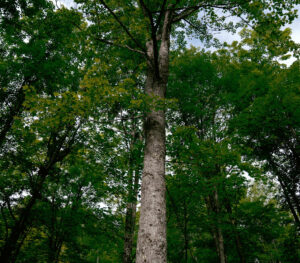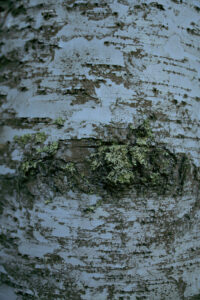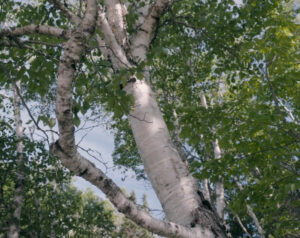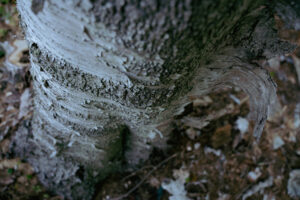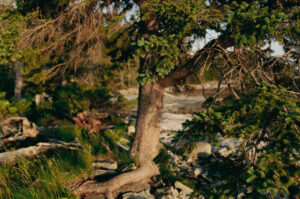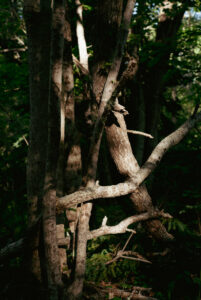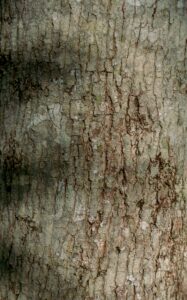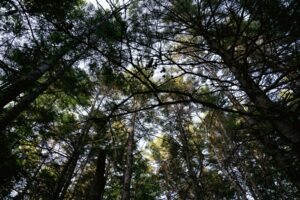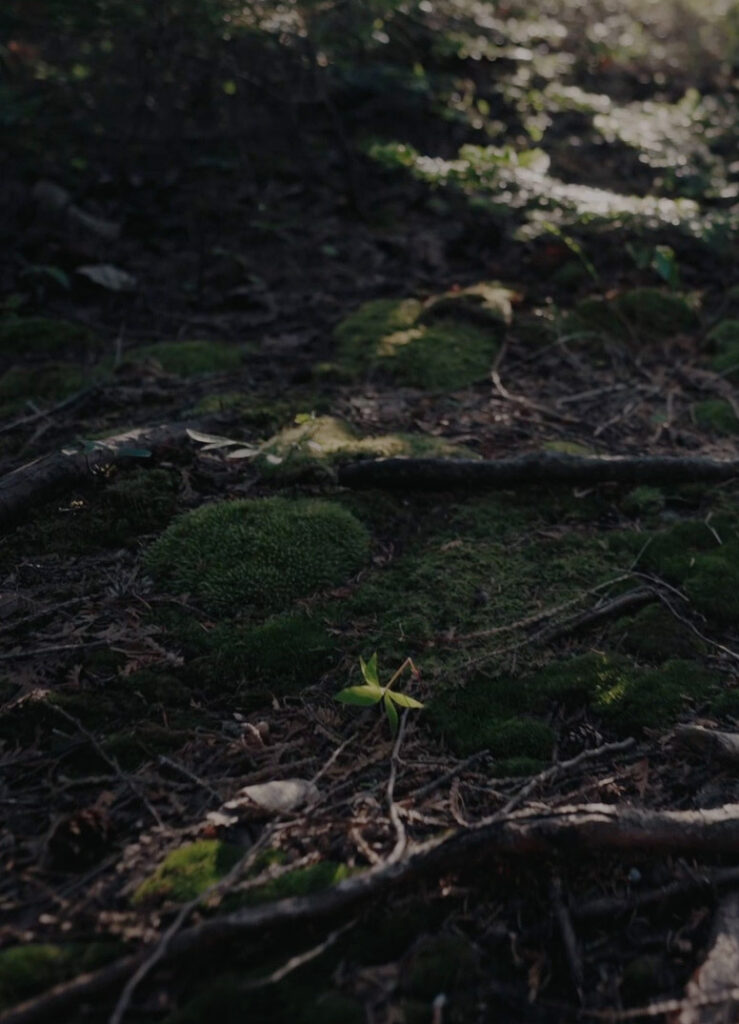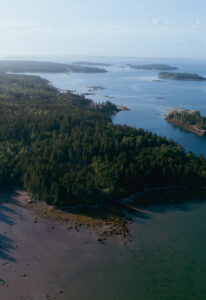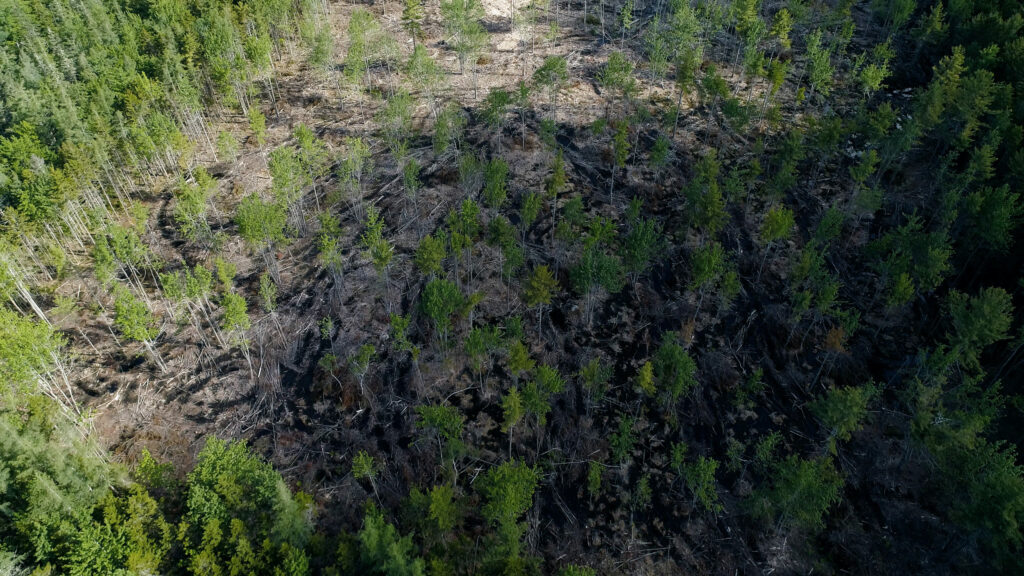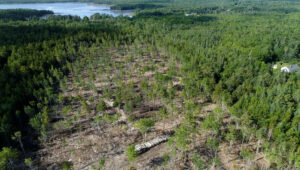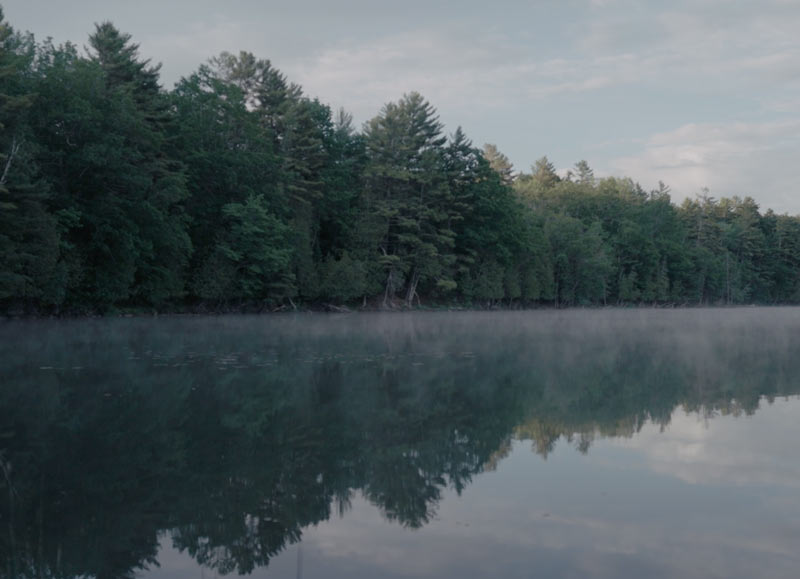Black Ash
It is early June in Orono, Maine. The sun will rise a few minutes before five, but the sky has already been turning into the light for nearly an hour, perhaps because the veery, robin, and hermit thrush are singing the day into being.
In a quiet neighborhood just a mile and a half from the University of Maine, a small conserved parcel of wooded land rests in the softness of dawn. A creek runs through the woods; along the creek a black ash tree is growing amid apple, paper birch, and white pine. Tall and gnarled with knots and cracks in the folding bark that runs up her wide and weathered trunk, she is still at this early hour. Her lower branches have mostly broken off, the wounds healed over. The part of her that is green—her pinnately compound leaves with their finely serrated leaflets—is high in the canopy, poised to drink in the rising sun.
She is the seed source tree: the eldest ash in this small stand, perhaps nearing 150 years old and thus likely nearing the end of her life. Over the course of her many seasons, she has sent her children out to set their roots along the running water, which curves and bends. Her seeds are broad wings that hang in clusters and spin in the wind when released.
Her children are growing up around her, some tall and woven into the layered canopy overhead, others still wrapping their first seasons around their slender trunks.
All of them are reaching, like their mother, into the dawn.
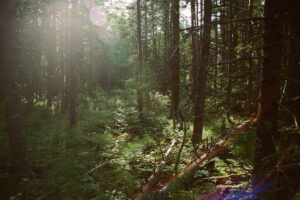
The United States has sixteen species of ash trees, genus Fraxinus. In the early 2000s, ash was one of the most common species in the Midwest: Ohio alone had an estimated four billion ash trees; three hundred million ash lined the streets of Michigan.
Black ash, Fraxinus nigra—interchangeably referred to as “brown ash” in Maine—is a keystone species that grows in forested wetlands and is well adapted to survive in the wet conditions that it prefers. Its leaves are late to arrive in the spring, providing an open canopy for bloodroot, trout lilies, fiddleheads, and other spring ephemerals along the forest floor that rely on ample light to get established. Its range extends from western Newfoundland to southeastern Manitoba and eastern North Dakota, and south to West Virginia. It grows in peat bogs and along streams, in poorly drained swamps and coniferous and hardwood forests. It is a tree that prefers seasonal flooding and moving water.
In the early 1990s, a cargo ship arrived in the port of Detroit, carrying pallets made of unprocessed ash wood from East Asia, where cousins of North American ash trees live. Along for the ride were several emerald beetles, each only half an inch long.
The beetles emerged into the world with an inherited recognition of the ash tree’s chemical scent and soon found their way to ash living in and around Detroit. The females laid their eggs on the bark of these trees, and when the eggs hatched, the larvae bored into the bark. Between the bark and the wood of the tree, the larvae then ate their way through the cambium and phloem—the layer of living tissue that contains the tree’s life-giving arteries, which pull sunlight in the form of sugar down to the roots and water and nutrients up from the soil. The larvae ate and ate and ate in a zigzag pattern that girdled the trees, resulting in the death of every tree they infested. And again, they emerged as emerald beetles. Again, the beetles followed the scent and found new ash trees.
No one could figure out what was killing all of the ash.
No one in the United States yet knew that there was such a thing as the emerald ash borer or just how rapidly it was spreading.
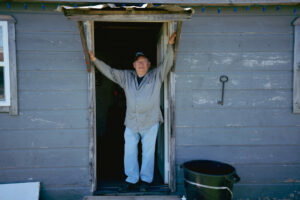
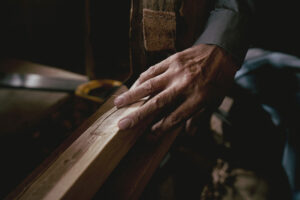
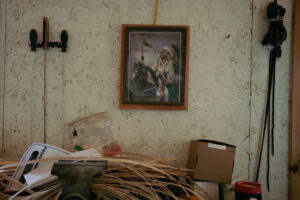
“I realized that there were only two or three
families that … knew how to go out in the woods
and select the trees and prepare the splints for baskets…
It’s a dying art.”
Portrait of Richard Silliboy
This film profiles Richard Silliboy, tribal elder and vice chief of the Aroostook Band of Mi’kmaqs and a black ash basketmaker.
A few miles outside of Littleton, Maine, in what today is known as Aroostook County (Aroostook means “clear” or “beautiful water” in the Mi’kmaq language), it’s unusually hot in this northern reach of the state, still in the nineties and stiflingly humid even though the sun has vanished below the horizon. The black flies are out in droves, adept at wriggling beneath hat brims and behind ears, inflicting bites that leave welts and trails of blood. Richard Silliboy is dressed in a plaid long-sleeved shirt, jeans, and a white ball cap, opting for the discomfort of the heat over the nuisance of the bugs. In his mid-seventies, he has a stout frame and a well-worn smile. His movements are slow and deliberate; he likes to crack jokes. He returns his bug spray to the cab of his pickup, where a Patriots cushion rests in the driver’s seat, and then retrieves an axe from the bed of the truck and hands it to me. “You can hold this,” he says. “But if a bear comes, hit ’im.” He chuckles to himself and begins to walk into the woods, then pauses and half turns back to add: “Hit ’im hard, though.”
Richard found this small grove of ash, sugar maple, hemlock, and black spruce trees a little over a decade ago. He was making a basket and ran out of wood, so he went looking for more. These days, black ash doesn’t grow as abundantly around Littleton as it did when he was a boy, so he wasn’t looking anywhere in particular. He turned on one road, then another, following his intuition. When this modest forest came into view, a moose was standing in the clearing as if waiting for him. It turned and walked beneath the trees. Richard followed and came to a small stand of black ash. He received permission from the landowner to harvest.
“I’ve harvested here just a few times,” he says, walking through thigh-high ferns. “Since the last time I was in here, they came in and clear-cut this place and cut it pretty hard. I don’t know if there’s any ash left in here or not. I’ll take a look around.”
Richard is a tribal elder and vice chief of the Aroostook Band of Mi’kmaqs, one of the five tribes that make up the Wabanaki Confederacy in Maine today, which includes the Maliseets, Passamaquoddy, Penobscot, and Abenaki. Wabanaki means “People of the Dawnland.” Their ancestors have been in Maine since the glaciers receded twelve thousand years ago.
Richard’s family moved to Aroostook County in 1951, when he was four years old, the youngest of eight children. His mother raised them by herself, earning money by plucking seed in the spring, raking blueberries in the summer, and picking potatoes in the fall. “In Aroostook County here, which used to be the potato capital of the world, they grew 250,000 acres of potatoes,” says Richard. “All of that was harvested by stoop labor, and each and every individual had to have what we call a potato basket.”
Richard’s mother was a basketmaker. She learned the art from her mother, who had in turn learned it from her mother, and back through the generations. She wove them primarily out of black ash, and sometimes cedar. Wabanaki people have been making baskets from black ash, birch bark, and sweetgrass for thousands of years. “Basketmaking is the oldest art in the Northeast,” says Richard.
Black ash is an ideal basket tree. The particular hydrology of black ash habitat causes the tree to grow in a particular pattern: a ring-porous tree, the spring wood has larger pores than the summer wood, which enables the wood to be easily split along the growth rings. Basket-quality ash tends to grow in wet areas that receive moderate light and have flowing or seeping water.
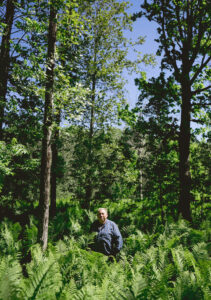
When I’m working on a basket, I’m using something that’s very sacred to all the Wabanaki people.”
When Richard’s brothers were old enough, they took jobs on the land, either in the woods cutting pulp for Maine’s paper industry or working on farms. His oldest brother would scout for black ash to bring home to their mother on the weekends. At age six, Richard would hold the flashlight outside as his brothers pounded ash boles with the back of an axe, separating the splints along the growth rings; later he’d burn the wood shavings as his mother and brothers processed the splints further, shaving off rough edges and frays with their crooked knives as they processed splints into standards, weavers, or wrappers. The heartwood was set aside to be carved into hoops and handles.
Richard started weaving around age ten. “Of course, I never made the bottoms. Mother would start the sides up a little bit, and I would finish it off. I got to where I could nail the hoop and rim onto the basket when it got that far.”
Together, the family would make up to twelve dozen large potato baskets every week. They sold them for fifty cents apiece.
In the fading light of the forest, Richard swats a fly as he walks through the ferns, remarking on the bear tracks that have depressed the mud next to his own footprints. He comes to a black ash tree and keeps his hand on the trunk as he walks a circle around it. It has the characteristics that he looks for: a bole that is straight for five or six feet, with no knots or twists or curves; corky bark that is flexible and moist, an indication that the tree has had good exposure to moving water and that the growth rings are therefore good for splints. He returns to the truck for his chainsaw and his pouch of tobacco to make an offering.
Black ash is called the Basket Tree. Where there are black ash trees in North America, there are likely to be generations of basketmakers who have carried this tradition forward for hundreds—in many cases, thousands—of years; among them are not only the Wabanaki people but also the Indigenous people of the upper Midwest and southern Canada.
“Working with the brown ash is very sacred for me,” says Richard. “For one thing, it’s very spiritual. When I’m working on a basket, I’m using something that’s very sacred to all the Wabanaki people. Our creation story is that the Creator put Glooscap on the Earth, and the Earth was barren, and Glooscap created the trees and the grass and also created the animals. And then he realized that he needed something to take care of the animals and take care of Mother Earth. Any Natives across the United States or Canada, they’ll tell you that it’s our job to take care of Mother Nature and Mother Earth. When Glooscap was going to create man and woman—create the Natives—he took his bow and arrow and shot it into a brown ash tree, splitting the tree open, and out came the Natives, dancing and singing.”
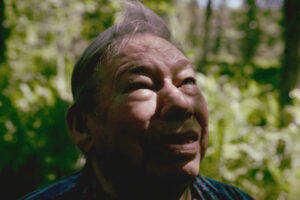
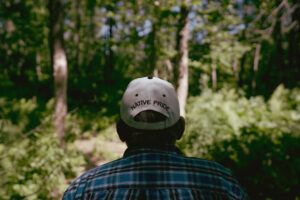
When Richard was a boy, the men who cut pulp to bring to the paper mills would yard trees out of the forest with horses, an energy-intensive effort that required them to be selective about which trees they felled. Black ash—long considered a “junk tree” by the forest products industry—was thus left standing, while spruce, fir, and oak were dragged out of the forest. Some of the local loggers would take the time to tell Richard’s mother the places where they had come across black ash in the woods.
By the mid-1980s, Aroostook County’s days as the potato capital were at an end. Though potatoes were still a major crop in the region, landowners relied less and less on Wabanaki basketmakers as smaller farms were consolidated into larger operations and became increasingly automated. As the family farms disappeared, basketmakers lost established relationships with farmers who had permitted them access to stands of black ash on private property to gather materials for the baskets the farmers relied on. “It wasn’t an equitable relationship, but it was reciprocal,” says Gabriel Frey, a Passamaquoddy basketmaker.
Meanwhile, the forests in northern Maine had entered a new phase of logging. Harvesting machines had largely replaced saws and horses and could take down entire stands efficiently; loggers had little incentive to discriminate between species. Where they were once left standing, black ash now came down with everything else.
With fewer trees, less access, and an agricultural industry that no longer provided a living to basketmakers, Richard—now in his late thirties—looked around his community. “I realized that there were only two or three families that were well enough and young enough, and knew how to go out in the woods and select the trees and prepare the splints for baskets,” says Richard. “I said to myself, It’s a dying art. In another generation there will be no basketmakers.”
Richard, by this time a husband and father, made the decision to return to his own basketmaking. He knew he would need to relearn the skill.“What I remembered and what I was capable of were two different things. My new baskets didn’t look the way I envisioned. But I kept at it.” Whereas some Wabanaki basketmakers make what are called “fancy baskets”—delicate, artistic baskets woven from thin splints with ornate designs—Richard began making utility baskets, primarily the potato baskets that his mother had made.
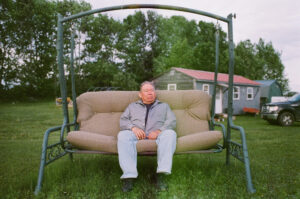
Richard’s house is small and white with Christmas lights running along the perimeter. Dandelions have sprung back up from his recently mowed lawn. The lilacs are blooming. Out by his workshop a sudden tok tok tok startles a chipmunk who has just poked his head out of a woodpile to greet the morning. Richard is pounding the back of an axe with a stick, splitting an ash bole in two. Tok tok. The axe moves farther into the center of the splitting tree until—with a cascading, gentle crack—the two pieces fall in opposite directions into the grass. Richard splits the halves again so that the bole is quartered. He removes the heartwood and then uses his axe to peel the bark from the tree.
He lays one-quarter of the bole horizontally and begins to pound it with the blunt side of the axe. Slowly, the wood begins to split, curling upward in uniform layers of off-white wood.
In and around Littleton, logging trucks are getting on the road, their beds stacked with trunks. Whereas Richard and his family could once find plenty of ash in and around their home, he must now often travel an hour or more north to harvest. Over the years, he’s had an increasingly hard time finding basket-quality trees.
“The forest is very sacred to us,” says Richard. “I know that they’re replanting. But they’re not replanting brown ash. They’re replanting something that they can reharvest in another forty, fifty years. Some type of tree that will grow fast that they can make another dollar on.”
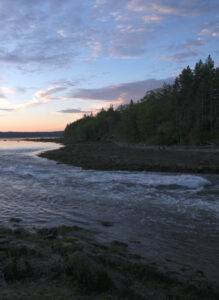
In 2002, foresters in Michigan finally figured out what was killing all of the ash trees. That summer the Michigan Department of Agriculture issued a quarantine in the five counties surrounding Detroit, the epicenter of the emerald ash borer invasion—where 99.7 percent of mature ash trees had died—and began urgent educational campaigns about the borer (commonly referred to as EAB). But by the end of 2003, EAB was in thirteen counties in Michigan and had been found in Ohio. In 2004, the United States Department of Agriculture began cutting down healthy ash to create buffer zones. Canada cut a swath of ash trees that was six miles wide, from Lake St. Clair down to Lake Erie. By 2012, EAB was in fifteen states and two Canadian provinces, and an estimated 50–100 million ash trees had been lost. The economic impact of tree removal and replacement across a twenty-five-state region was projected at $10.7 billion.2
On its own, the beetle might only move a half mile a year, but people were cutting dead ash trees, not knowing what had killed them, and chopping them into firewood, which was sold and carried across county and state lines—neither the sellers nor the buyers ever aware that beetle larvae were nestled inside.
Despite years of education campaigns, expanding quarantine zones, and bans on moving firewood, the borer, as of this writing, has spread into thirty-five states and five Canadian provinces. APHIS—the Animal and Plant Health Inspection Service—has since abandoned quarantines and firewood bans as effective strategies for control, though individual states like Maine still have quarantines and bans in place. APHIS is instead focusing its efforts on other methods of slowing EAB’s spread, such as biological control: in this case, releasing parasitoid wasps that are native to EAB’s habitat in Asia and a known predator of the beetle. So far, this strategy has had a limited but encouraging effect.
In 2017, the International Union for the Conservation of Nature added six species of North American ash to its Red List, with black ash, blue ash, green ash, and white ash listed as critically endangered.
All of them had been common species in 2002.
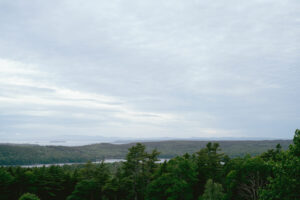
The present-day story of tree migration in Maine—indeed, anywhere—is not a simple one. While one can broadly point to climate change as the culprit, the closer one looks, the more complex the image appears. When I asked Patty Cormier, director of the Bureau of Forestry and Maine’s state forester, if she could give me a big-picture overview of how forests in Maine are changing in response to a changing climate, she said: “Nope. It’s very complex. There’s so much that goes into it. You can’t simply look at one factor with our forests and make predictions about the future.”
The fact that Maine’s boreal forest is creeping north into cooler climes does not directly and wholly correlate with rising temperatures—though the annual average temperature in Maine has increased by 3.2 degrees Fahrenheit since 1895, with most of the warming occurring in the winter months. That sugar maples and birch are being increasingly replaced by beech trees in what used to be widespread beech-maple-birch forest ecosystems, where the three species had coexisted in a balanced relationship, cannot be fully attributed to changes in seasonal patterns nor to the fact that summers have lengthened by about two weeks while winters have shortened by the same amount. And the ongoing decline of eastern hemlock, which has been plagued by the rapid expansion of hemlock woolly adelgid, can be accounted for only in part by the decreasing depth of annual snowfall.
The external factors that affect the health, makeup, and movement of forests are as complex as the forests themselves. The phenomenon of tree migration arises from interrelated and overlapping causes, such as changes in climate, past and present land use and management, the proliferation of native pests and plants, the introduction of non-native species, and the built landscape. And because researching tree migration often requires studies that last at least several decades, in most cases we do not yet have enough data to see the picture fully. Attempting to follow the trees—or trying to predict where they will go—currently means a lot of guesswork and few definitive answers.
But Maine is nonetheless a useful case study for a better understanding of tree migration within the United States. With 89 percent of its land forested, Maine has the highest percentage of forest of any state. Additionally, the forests of Maine exist in a transitional ecotone, with boreal forests (primarily spruce and fir) to the north and temperate hardwood forests (primarily maples, birches, and beeches) to the south: thus, many species already exist at or near the edge of their natural range, making it easier to perceive where those edges are expanding or contracting.
Other noteworthy factors for our purpose: 93 percent of Maine’s forest is privately owned and managed; 97 percent of Maine’s forests are classified as timberland. The forest products industry—which includes pulp and paper, hardwood and softwood boards, panels, dowels, wood composites, Christmas trees, firewood, and maple syrup—contributes upwards of $5 billion to Maine’s economy every year, while forest-based recreation contributes nearly $3 billion. “The trees are all over the state, and it’s our identity,” says Patty Cormier. “So it’s huge. I take that very seriously. I want to keep it that way.”
At the time of European settlement in the 1600s, there were 18.2 million acres of forest in Maine, compared with today’s 17.6 million. Though this might give the impression that comparably little forest has been lost in the last four hundred years, that impression is false. Most of the forests of southern Maine were razed to make way for agriculture. Following the industrialization of the Northeast in the mid-1800s and the relocation of much of the nation’s agriculture to the Midwest, many of southern Maine’s farms and remaining forests were felled under increasing pressure from development, which has only increased into today. Between 1980 and 2000, development altered 850,000 acres of the state’s forests. Landscape disturbance is a particular threat to tree migration. One study attests that once 70 percent of an area has been disturbed, the ability of plants to migrate is effectively halted.
Following settlement, the northern part of the state was quickly identified as prime timber country. Bangor was known as the “Lumber Capital of the World” by the mid-1800s, and the subsequent rise of the pulp and paper industry shortly thereafter kept forests in the northern part of the state under a near-constant regime of cutting. The forests that have regrown on what was farmland in northern Maine are younger forests with reduced diversity. Though the forest products industry has been in decline in the state for the last decade, demand for forest products remains a major factor in the state’s economy, only recently outpaced by the service industry.
The state’s history of clear-cutting in the north and clearing for agriculture in the south has by and large determined what tree species make up Maine’s forests today. Thus, in considering where forests will be in the future, one must take into account where they have been in the past, as well as the fact that the majority of those forests have already been drastically—and repeatedly—altered since European settlement. There are only about six thousand acres of old-growth forests remaining in the state. Everything else has been felled at least once.
“Northeastern forests continue to recover from a long period of intensive agricultural clearing and lumbering that peaked in the late nineteenth century,” one study of New England forests notes. “Despite the pervasive influence of many novel agents of global change, recovery dynamics … continue to be the dominant process driving forest change in the region.”3 Even black ash, a comparably rare species in Maine—making up about 2 percent of forests—exists where it does in the state today largely because of agricultural use of the land. Many stands in central and southern Maine are part of early-successional forests that are less than a hundred years old, having regenerated on abandoned farmland.
In other words, humans have been altering the future paths of Maine’s trees for centuries.
Climate models predict that Maine will be between three and fourteen degrees warmer in winter by the year 2100—a wide range that underscores the unpredictability of the climate crisis. Precipitation is expected to increase, primarily in the form of rain; the number of days with extreme high temperatures is expected to double; and average snowfall is expected to continue to decrease. The decline in winter snow will bring changes to the biological processes of soil, will lead to the increased proliferation of pests, and will affect wildlife foraging and nesting. Without the insulation of snow, cold snaps can freeze soil and fine roots.
Broadly speaking, Maine is expected to see a large decline in its boreal forests—which are dominated by red spruce, black spruce, white spruce, and balsam fir—by the end of the twenty-first century. These trees are moving north and upslope, and while they are likely to find some refuge in the higher elevations of New England’s mountains, their populations are likely to greatly diminish. One study from the University of Vermont predicted that New England will lose between 71 and 100 percent of its boreal conifer forest by 2085. In the meantime, northern deciduous hardwood forests are also predicted to decline, while the oak-hickory forest type will shift northward by an estimated one hundred kilometers. Hardwood species with established southern ranges—red maple, northern red oak, and beech—are expected to move farther northward and to increase in abundance as Maine’s climate transforms into something more akin to that of Pennsylvania.
These predictions raise what are for Jesse Wheeler—vegetation program manager at Acadia National Park—an uncomfortable but urgent set of questions about the role of human intervention in the movement of forests. “How much do we try to facilitate what’s going to be coming in? What I mean by that is, if there are species that aren’t growing in the park now—that aren’t natural to this area in 2021—but do have suitable habitat and are growing in populations, let’s say, 50–100 miles from here, what can we do to allow for those to come in and establish? … It’s unlikely with natural seed dispersal that they’ll be able to get here, even within the next century, let alone decades, because of the built landscape primarily just prohibiting that. You’ve got concrete and pavement that’s really preventing … natural dispersal.”
In other words, stepping back and allowing trees to arrive naturally on their own time is, in many places, not an option. And while comparably rapid changes in temperature and precipitation would already be enough to move forests, there are other factors that have the potential to change where trees will be able to thrive: particularly invasive plants and pests.
Dr. William Livingston, associate professor of forest resources at the University of Maine, has spent thirty-five years observing Maine’s forests. In that time, the most significant changes he’s seen have not been drastic shifts in ranges of native trees but the arrival of invasive plants. “That’s happening to a much faster extent and impacting the natural communities to a great extent,” he says. “If there’re any vegetation changes I’m concerned about, it’s with the invasive plant species coming and getting into our natural systems.”
Even if species could find green corridors through the built environment, many non-native plants and insects are poised to move into transitioning forests faster than the trees. Jesse Wheeler and his colleagues, therefore, have to do their best to predict—decades ahead of concrete research—which trees will lose suitable habitat and which trees might be able to replace them, while factoring in ongoing management of the many invasives that have already arrived. “What do we select?” he asks. “And how do we select? And how do we grow and source?” Human management is a must, at least in parts of Acadia, if the forests are to remain forests.
Before the threat of the emerald ash borer, Maine’s population of black ash trees was widely expected to sustain losses in habitat. With predicted changes in precipitation—including wetter wet periods and drier dry periods—there were likely to be changes in the hydrology of the wetland and riparian ecosystems where the trees grow. It was not fully known how the trees would respond, in part because such things are difficult to predict, and in part because the trees make up such a small percentage of Maine’s forests—having little value in the state’s mainstream economy—and thus has not been extensively studied. But even in his lifetime, Richard has seen black ash leave the Littleton area, a phenomenon he believes is not entirely to be blamed on logging.
Wabanaki people in Maine have been watching closely and with a clear sense of what is at stake as the emerald ash borer moves east. Black ash is not only an ecological keystone species but a cultural keystone species as well. The tree is part of Wabanaki cosmology and creation stories. Passing down the knowledge of basketry has long meant passing down stories, language, and tradition. Baskets have provided a critical source of economic, and therefore social and physical, well-being for tribal basketmakers since the arrival of European settlers and into today.
As the emerald ash borer—considered the most destructive forest pest in the country’s history—has moved east across the United States, it has left graveyards of ash trees in its wake. Most predictions are dire: the borer is expected to eventually kill 98 to 99 percent of ash trees in North America.
Can we say, then, that black ash is migrating? Is it shifting its range, or is its range being erased? Can we tease out the patterns of global trade that brought the borer to American shores from the bigger pattern of a warming planet? From the demand for timber? From people fleeing the arrival of the climate crisis elsewhere—fire and drought and floods—and coming to Maine and clearing forests and developing land that will buy them and their families a more secure climate future?
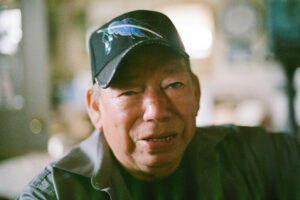
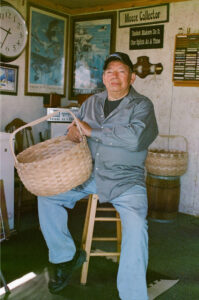
The emerald ash borer arrived in southern Maine in 2018.
Inside his workshop, Richard finishes wrapping the hoop of one of his large potato baskets. He does not nail the rim but secures the basket by tucking the end of the final weaver into the side of the basket so that the wood makes a diamond shape just below the bottom of one side of the handle where it meets the rim—one of the trademarks of his work. He bounces the basket between his hands several times, feeling the weight of it, and then flips it over to sign the bottom:
Richard Silliboy, June 9, 2021. Mi’kmaq.
“It’s sad what’s going to happen to the basket wood and the basketmakers,” he says. “My mother used to make baskets out of cedar, and I might have to learn how to do that if I live long enough. There’ll [probably] be enough brown ash to supply me for what time I have left.”
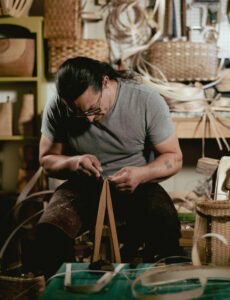
Before settlement, pests and disease outbreaks within forest ecosystems were natural occurrences, caused by native species. Spruce budworm, for example, regularly infested spruce trees on a thirty-to-sixty-year cycle. But the forest was adapted to such disturbances and had time to adapt and recover. Now, with the increasing frequency of non-native insect introductions—four hundred in New England alone since the mid-1800s—pests arrive in areas where trees have no natural defense in place; Asian longhorned beetle and hemlock woolly adelgid are two devastating examples. In Asia, where ash trees and the emerald ash borer coexist in a shared ecosystem of checks and balances, ash trees have evolved a defense against the borer, in which they create a chemical compound that makes the wood more difficult for the beetle to digest. Because of this, EAB almost exclusively targets weakened, dead, or dying ash trees in its native ecosystem, leaving healthy trees alone. Because the borer arrived in the United States only very recently, species of North American ash have not yet evolved to have any defense against the beetle.
By the time EAB was discovered in Maine, the Wabanaki community, including Gabriel Frey and Suzanne Greenlaw, had been preparing for the pest’s arrival for more than a decade. “It was sort of like watching this tsunami coming,” says Gabe. “And there’s no way to get to higher ground. That’s it. It’s going to devastate the species.”
Gabe is a thirteenth-generation Passamaquoddy basketmaker in his early forties. He is sitting on the steps of his front porch holding a cup of coffee, from which steam is rising and occasionally fogging his rectangular glasses. His hair is pulled back into a ponytail. Behind him in the backyard, a large painted sign reads “Freytopia Garden” in playful letters, and a line of raised beds extends across the yard.
“I grew up around baskets; always had ash in the house,” Gabe says. “When you walk into my mother’s house, even today, the smell of sweetgrass bombards you. It became so commonplace that I never really thought about it as anything.” When he was eighteen, his grandfather, a black ash basketmaker, was diagnosed with emphysema. Gabe had made baskets before then, but his grandfather’s illness sparked the realization that the knowledge and wisdom that had been passed down to him through the generations was finite. “You realize the preciousness of that knowledge,” he says. “[That] there’s a door closing and you have this limited access to it.” Gabe grew up in traditional Passamaquoddy territory, in between present-day Portland and Littleton, what today is known as Downeast Maine. He and his wife, Suzanne, have lived in Orono for five years. Suzanne, a Maliseet woman, is getting her PhD at the School of Forest Resources at the University of Maine. Their two children, Musqon, eight, and Alamossit, four, are running around the house and yard, appearing and reappearing in blurs of color and torrents of laughter in true summer vacation fashion.
Along with Richard, Gabe and Suzanne are part of the University of Maine’s Sustainability Solutions Initiative (SSI), funded through a grant from the National Science Foundation. A partnership between the Maine Indian Basketmakers Alliance, university faculty, scientists, graduate students, and other community stakeholders, this group is focused on engaging Indigenous research methods and knowledge in order to recognize and prioritize the ecological and cultural importance of the black ash and to, essentially, buy the tree and Wabanaki basketmakers as much time as possible in the face of the emerald ash borer. They are collecting seeds to send to storage facilities in Colorado, documenting genetic diversity in basket-quality trees, and engaging in APHIS’s strategy of releasing parasitoid wasps as biological controls. (The wasps are a natural predator of the emerald ash borer in Asia; releasing them in forests infested by EAB is thought to be relatively safe to the wider ecosystem, but of course there is no way to be completely sure.)
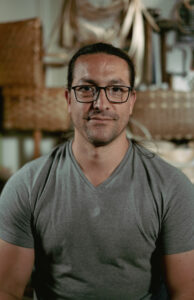
“There’s so many aspects of our culture that are intrinsically connected with black ash. If you look through history, there are parts of our culture that [we] were only able to sustain through basketry.”
Portrait of Gabriel Frey
This film profiles Gabriel Frey, a thirteenth generation Passamaquoddy black ash basketmaker and cultural knowledge keeper.
SSI works from the premise that Indigenous people across North America have been intimately involved in the management of forests for millennia. As Richard and Gabe both expressed, there isn’t a clear separation between “human culture” and “wilderness”; the two have existed in a reciprocal relationship. Darren Ranco—associate professor of anthropology and coordinator of Native American Research at the University of Maine, one of the SSI participating faculty, and a member of the Penobscot tribe—contributed to a paper entitled “People Have Shaped Most of Terrestrial Nature for At Least 12,000 Years,” which states:
Human societies have been shaping and sustaining diverse cultural natures across most of the terrestrial biosphere for more than 12,000 years. Areas under Indigenous management today are recognized as some of the most biodiverse areas remaining on the planet, and landscapes under traditional low-intensity use are generally much more biodiverse than those governed by high-intensity agricultural and industrial economies. Although some societies practicing low-intensity land use contributed to extinctions in the past, the cultural shaping and use of ecosystems and landscapes is not, in itself, the primary cause of the current extinction crisis, and neither is the conversion of untouched wildlands, which were nearly as rare 10,000 years ago as they are today. The primary cause of declining biodiversity, at least in recent times, is the appropriation, colonization, and intensifying use of lands already inhabited, used, and reshaped by current and prior societies.
But many modern practices and policies of forest management in the United States have left Indigenous people and knowledge out of the conversation, an oversight which SSI is seeking to rectify.
“The method of harvesting [black ash] that we practice,” says Gabe, “is not necessarily harvesting in the western sense, but more stewardship.”
Black ash serves and maintains the wetland and riparian ecosystems where it grows. The accepted practice when harvesting black ash is to carefully and selectively fell mature trees, which will create a gap in the canopy, giving ash saplings the light they need to grow both healthier and straighter. A healthy stand of ash, in turn, contributes to the even regulation of the hydrology of a wetland and helps to sustain the ecosystem’s biodiversity.
Suzanne’s doctoral research, overseen by Professor Ranco and Professor John Daigle, focuses on how to better incorporate practices like these, which are part of the Wabanaki people’s traditional ecological knowledge, into academic and scientific research. Her work aims to bring Indigenous voices to the table around issues of access to natural resources—something she considers a vital aspect of tribal sovereignty. Suzanne has been consulting with scholars, scientists, Wabanaki basketmakers, and foresters about ways of using GIS mapping to locate potential sites where black ash might grow as one strategy to build ecological resilience for the species—which is deeply tied to the cultural resiliency of her people.
While Suzanne is leveraging Indigenous science to shift the ways we approach and study forests—by upholding an ethic of place-based knowledge and what she terms “ground-truth”—Gabe has found his own way of ensuring cultural resilience by picking up the basketmaking tradition of his grandfather and his mother and becoming a cultural knowledge keeper. “There’s so many aspects of our culture that are intrinsically connected with black ash. If you look through history, there are parts of our culture that [we] were only able to sustain through basketry. The language was carried on through teaching baskets; it was a communal activity. Our ability to resist colonization is tied to basketmaking. We were able to maintain our cultural, traditional practices through basketmaking and avoid the federal policy of withholding rights.”
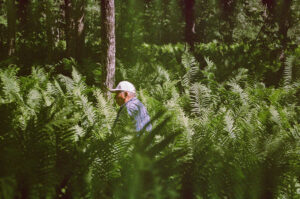
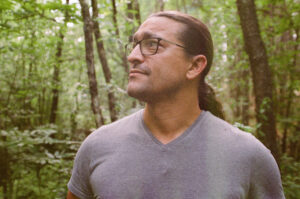
In the 1800s, Indigenous people across the continent were forced onto reservations and assigned an Indian agent who would monitor how well they were “assimilating,” controlling their access to food and sustenance accordingly. “They were literally starving the culture out of people,” says Gabe. “That was a federal policy.… Growing up, my grandfather said, ‘If you know how to make baskets, you’ll never go hungry.’”
The SSI team, knowing it was only a matter of time before EAB crossed state lines, sent Richard and four other tribal members to Michigan to see what an infested stand looked like and how quickly the presence of EAB in an area could sound the death knell for the surrounding ash trees. A larger tree will die within four years of an infestation; a stand will sustain critical damage within five to ten years. Today, of course, Richard and his colleagues don’t need to travel far from home to see the impact of the beetle.
Options for reestablishing the black ash population are limited, and none have been sufficiently tested to know if they will work. Some are looking into inoculating seed source trees, some are working to process as much basket material ahead of time as possible, while others are concentrating on finding ash trees that have a natural resistance to EAB. Efforts to replant following the loss of a stand present significant challenges. Once the overstory of an ash stand has been lost to the borer, the surrounding water table, having lost the regulatory presence of ash trees, can rise and begin to convert a wooded wetland into an open-water wetland, where black ash will have a more difficult time reestablishing itself. And while larger gaps in the canopy might allow ash saplings to grow and replace their fallen elders, the dramatic increase in the amount of light that occurs when the majority of the canopy is diminished also increases the likelihood that other species will outcompete the ash. EAB attacks even very young trees and will return to a stand repeatedly over a number of years.
“It does feel like my daughters will be the first generation in thousands of years not to be able to pass this art form on to their children,” says Gabe. “In that sense, it’s pretty heartbreaking.” He gives a self-deprecating smile in response to his pessimism and qualifies his comment: “Every time I say that, Suzanne is usually in the corner going, ‘Well, that’s one opinion.’”
Maine continues to enforce quarantines and bans on moving firewood. Other efforts to save the species include sending seeds to a seed bank in Colorado in the hope of replanting once the beetle is no longer as much of a threat; releasing the parasitoid wasps; and finding suitable ash habitat where black ash does not yet grow but could be planted.
“[Sometimes] I struggle with what’s even the point if we can’t carry it on,” says Gabe. “Maybe when my kids are grandparents, there will be some seed source that’s still available, and they’ll have that knowledge. Maybe it will skip a generation, but it’ll still be there.”
In his workshop, Gabe separates the layers of a black ash splint, precisely peeling them apart into increasingly thin, inch-wide strands until the one in his hand measures just one-sixteenth of an inch thick.
“Our community, our culture, is one of reciprocity, relationships,” he says. “If I’m able to carry on this knowledge for the community and be a cultural knowledge keeper, then I feel like it’s a responsibility that’s necessary…. That’s also why I started. I saw a lot of people picking up the form, but they were doing the artistic avenue rather than this traditional version. I think both are important, but I didn’t see anyone picking up what my grandfather was doing. So I felt like … I had to step in to do that. And I really enjoy it. I really enjoy learning through each tree. It’s seeing how each tree expresses itself differently.”
Musqon and Alamossit can be heard running across the floor upstairs, shouting and laughing.
“We constantly exist in the unknown, and this is another aspect of that,” says Gabe. “Maybe this is the last generation. Maybe it’s not. Maybe the hopeful ones will actually come through and manifest.”
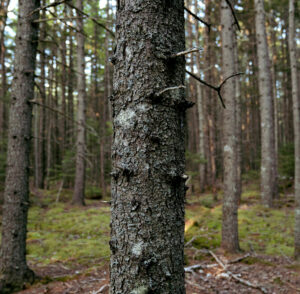
We might step again into a long view of time, now venturing into the future. We stand on the bank of a flowing river, several generations after the black ash trees have gone from the North American continent. Spring floods send the river water over the bank and into the trees. Perhaps saplings are growing up from the wet soil, nourished by the moving water, their serrated leaves unfurling into spring as the veery sings nearby. Perhaps they were planted here from carefully protected seeds, by hands who knew what a black ash needs to grow. Perhaps these trees will mature and send out seeds of their own.
And perhaps, someday, someone will come to this stand, with a memory of the language of weaving, looking for a tree from which to make a basket.
- Marguerite Holloway and George Etheredge, “New England’s Forests Are Sick. They Need More Tree Doctors.” The New York Times, Oct. 7, 2020 (updated Sept. 2, 2021).
- Research on EAB’s spread sourced from Zach St. George, The Journeys of Trees: A Story About Forests, People, and the Future (Norton: New York, 2020).
- Duveneck, M.J. et al. “Recovery dynamics and climate change effects to future New England forests,” Landscape Ecology 32, 1385–1397 (2017), https://doi.org/10.1007/s10980-016-0415-5.
